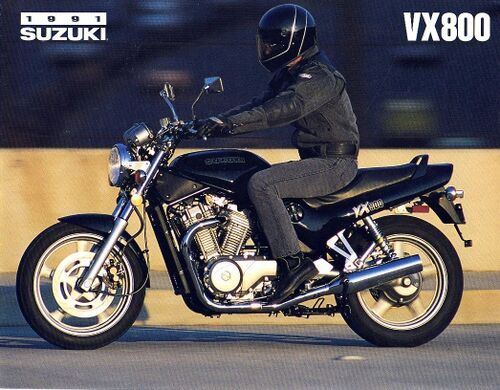Suzuki VX800
The Suzuki VX 800 was developed at the American Suzuki design studio in Brea, California between 1986 and 1989, and official series production began in 1990. This model has been sold in Japan, the United States and Europe. Production of the model was stopped in 1997, and sales in the United States ceased in 1993 due to extremely low demand. Meanwhile, in Europe, the VX 800 was on sale throughout the 1990-1997 release period.
The main versions of the Suzuki VX 800:
- Suzuki VX 800 (for the Japanese market) - has a shortened frame.
- Suzuki VX 800 (for the US market) - differs in the settings of the engine (connecting rod journals 45 °) and gearbox (gear ratio). The California version had a more suffocated exhaust to comply with local environmental regulations.
- Suzuki VX 800 (for the European market) - differs in engine settings (connecting rod necks 75 °).
The Suzuki VX 800 was based on an engine from Suzuki VS 750 Intruder with an increased volume of 805cc (similar to Suzuki VS 800 Intruder) and using oversized carburetors (36mm). In addition, the bike has received a reverse torque limiter from the Suzuki VS 1400 Intruder. The Suzuki VX 800 engine produced 63 hp. power and 73 Nm of torque. The maximum performance of the motor is at 6500-7500 rpm. European versions produced from 45 to 61 hp. (depending on the specific country).
The frame of the Suzuki VX800 is also similar to the one used in the Suzuki VS 750 Intruder, but with some differences.
Other features of the Suzuki VX 800 include a steel frame, simple suspension in the form of a conventional telescopic fork and double shock absorber, disc brakes, 17 'and 18' wheels, cardan drive, 5-speed gearbox, 18 l fuel tank and 213 kg dry masses.
The main competitors of the Suzuki VX 800 in the class:
Specifications
Specifications Suzuki VX 800:
| Model | Suzuki VX 800 |
|---|---|
| Motorcycle type | road (classic) |
| Release year | 1990-1996 |
| Frame | steel tubular |
| Engine type | 2-cylinder, 4-stroke, V-shaped |
| Working volume | 805 cc cm. |
| Bore / stroke | 83.0mm x 74.4mm |
| Compression ratio | 10.0: 1 |
| Cooling | liquid |
| Number of valves per cylinder | SOHC, 4 valves per cylinder |
| Fuel supply system | carburetor, 2x Mikuni BDS36SS / BS36SS |
| Ignition type | fully transistor |
| Maximum power | 63 hp at 7500 rpm (56.2 hp - at wheel) (45-61 hp - European versions; 57 hp - Japanese versions) |
| Maximum torque | 73 Nm @ 6500 rpm (69-72 Nm - European versions; 68 Nm @ 4500 rpm - Japanese versions) |
| Gearbox | 5-speed |
| Drive type | cardan |
| Front tire size | 110 / 80-18 58H |
| Rear tire size | 150 / 70–17 69H |
| Front brakes | 1 disc, 310 mm, 2-piston caliper |
| Rear brakes | 1 disc, 250 mm, 2-piston caliper |
| Front suspension | 41mm telescopic fork, 150mm travel |
| Rear suspension | double shock absorber (preload and rebound adjustment), travel - 118 mm (in versions E-01, E-03, E-28, E-33 - adjustable compression and rebound) |
| Fuel tank capacity | 18 L (19 L - in the E-33 version for California), including reserve - 4.0 L |
| Length | 2280 mm (versions E-15, E-16, E-17, E-22, E-25, E-39 - 2355 mm; versions E-18 - 2255 mm) |
| Width | 805 mm |
| Height | 1115 mm (versions E-03, E-28, E-33 - 1085 mm) |
| Wheelbase | 1565 mm (versions E-03, E-33 - 1555 mm) |
| Saddle height | 800 mm (versions E-01, E-03, E-28, E-33 - 795 mm) |
| Maximum speed | 186 km / h |
| Acceleration to 100 km / h (0-100) | 5.1 sec |
| Motorcycle weight (dry) | 214 kg (E-33 versions - 213 kg) |
Documentation
